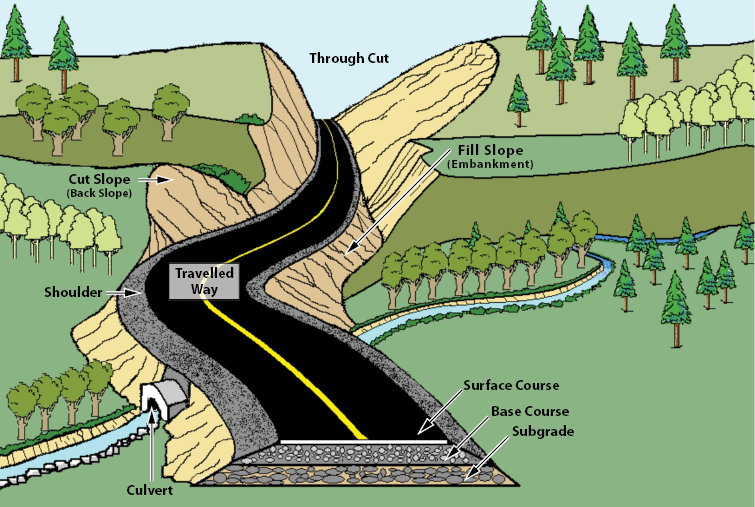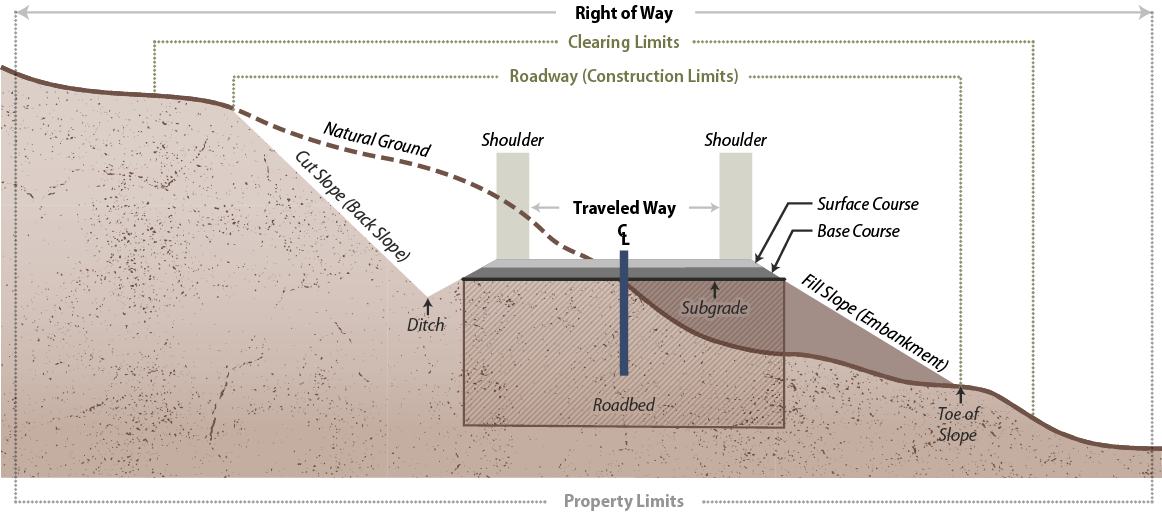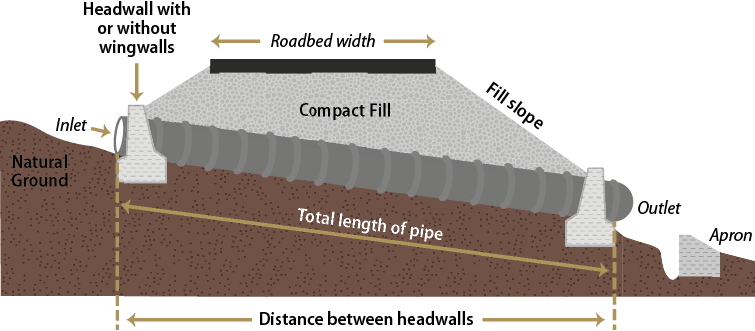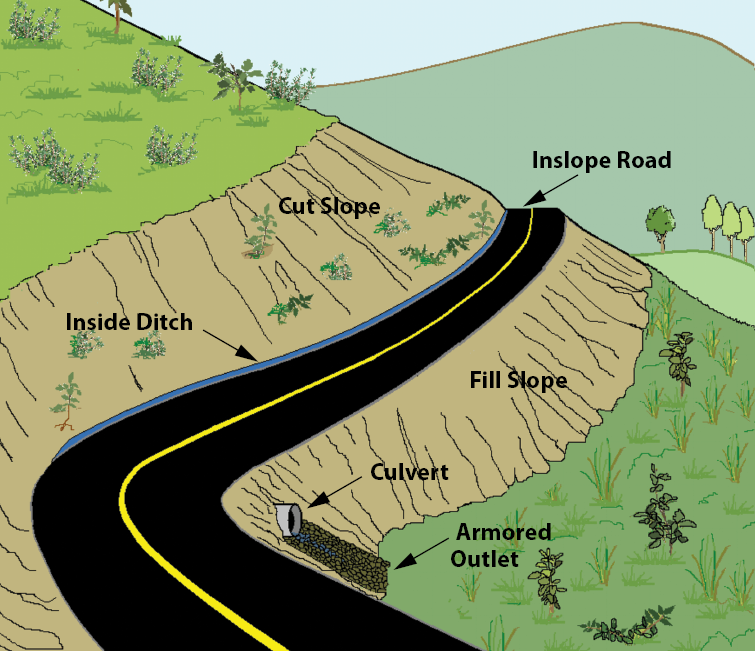ROADSIDE REVEGETATION
An Integrated Approach to Establishing Native Plants and Pollinator Habitat
2.6 Understanding Technical Concepts and Terminology
The ability to understand and utilize the technical concepts and terminology used by road engineers is essential to roadside revegetation planning. This ability enables the designer to contribute effectively to road design and construction processes, as well as to communicate revegetation needs and goals to others involved with the project. The following section introduces key technical concepts and terminology relating to road design and construction
Road Concepts and Terminology
The following terminology was adapted from Keller and Sherar 2003.
2.6.1 Road Components

Figure 2-10 | Terms used to define roads

Figure 2-11 | Terms used to define roads: cross-section
- Berm—A ridge of rock, soil, or asphalt, typically along the outside edge of the road shoulder, used to control surface water. It directs surface runoff to specific locations where water can be removed from the road surface without causing erosion.
- Buttress—A structure designed to resist lateral forces. It is typically constructed of large riprap rock, gabions, or well-drained soil to support the toe of a slope in an unstable area.
- Cross-Section—A drawing depicting a section of the road sliced across the whole width of the road. Can also apply to a stream, slope, or slide.
- Cut Slope (Back Slope or Cut Bank)—The artificial face or slope cut into soil or rock along the inside edge of the road
- Cut-and-fill—A method of road construction in which a road is built by cutting into the hillside and spreading the spoil materials in adjacent low spots and as compacted or side-cast fill slope material along the route. A "balanced cut-and-fill" utilizes all of the "cut" material to generate the "fill." In a balanced cut-and-fill design there is no excess waste material and there is no need for hauling additional fill material. Thus cost is minimized.
- Ditch (Side Drain)—A channel or shallow canal along the road intended to collect water from the road and adjacent land for transport to a suitable point of disposal. It is commonly along the inside edge of the road. It also can be along the outside edge or along both sides of the road.
- End Haul—The removal and transportation of excavated material off-site to a stable waste area (rather than placing the fill material near the location of excavation).
- Fill Slope (Embankment Slope)—The inclined slope extending from the outside edge of the road shoulder to the toe (bottom) of the fill. This is the surface formed when excavated material is placed on a prepared ground surface to construct the road subgrade and roadbed template.
- Grade (Gradient)—The slope of the road along its alignment. This slope is expressed as a percentage and is the ratio of elevation change compared to distance traveled. For example, a +4percent grade indicates a gain of 4 units of measure in elevation for every 100 units of measure traveled.
- Natural Ground (Original Ground Level)—The natural ground surface of the terrain that existed prior to disturbance and/or road construction.
- Plan View (Map View)—View seen when looking from the sky towards the ground (bird's-eye view).
- Reinforced Fill—A fill that has been provided with tensile reinforcement through frictional contact with the surrounding soil for the purpose of greater stability and load carrying capacity. Reinforced fills are comprised of soil or rock material placed in layers with reinforcing elements to form slopes, walls, embankments, dams, or other structures. The reinforcing elements range from simple vegetation to specialized products such as steel strips, steel grids, polymeric geogrids, and geotextiles.
- Retaining Structure—A structure designed to resist the lateral displacement of soil, water, or any other type of material. It is commonly used to support a roadway or gain road width on steep terrain. They are often constructed of gabions, reinforced concrete, timber cribs, or mechanically-stabilized earth.
- Right-of-Way—The area or footprint of land over which facilities such as roads, railroads, or power lines are built. Legally, it is an easement that grants the right to pass over the land of another.
- Road Center Line—An imaginary line that runs longitudinally along the center of the road.
- Roadbed—Width of the road used by vehicles, including the shoulders, measured at the top of subgrade.
- Roadway (Construction Limits or Formation Width)—Total horizontal width of land affected by the construction of the road, from the top of cut slope to the toe of fill or graded area.
- Side-Cast Fill—Excavated material pushed on a prepared or unprepared slope next to the excavation to construct the roadbed. The material is usually not compacted.
- Shoulder—The paved or unpaved area along the edge of the traveled way of the road. An inside shoulder is adjacent to the cut slope. An outside shoulder is adjacent to an embankment slope.
- Traveled Way (Carriageway)—That portion of the road constructed for use by moving vehicles including traffic lanes and turnouts (excluding shoulders).
- Through Cut—A road cut through a hill slope or, more commonly, a ridge, in which there is a cut slope on both sides of the road.
- Through Fill—Opposite of a through cut, a through fill is a segment of road that is entirely composed of fill material, with fill slopes on both sides of the road.
2.6.2 Road Structural Section and Materials
- Borrow Pit (Borrow Site)—An area where excavation takes place to produce materials for earthwork, such as a fill material for embankments. It is typically a small area used to mine sand, gravel, rock, or soil without further processing.
- Quarry—A site where stone, riprap, aggregate, and other construction materials are extracted. The material often has to be excavated with ripping or blasting, and the material typically needs to be processed by crushing or screening to produce the desired gradation of aggregate.
2.6.3 Surface Drainage
- Armor—Rocks or other material placed on headwalls, on soil, or in ditches to prevent water from eroding and undercutting or scouring the soil.
- Drainage Structure—A structure installed to control, divert, or move water off or across a road, including but not limited to culverts, bridges, ditch drains, fords, and rolling dips.
- French Drain (Underdrain)—A buried trench, filled with coarse aggregate, and typically placed in the ditch line along the road to drain subsurface water from a wet area and discharge it to a safe and stable location. French drains may use variable sizes of rock but do not have a drain pipe in the bottom of the trench.
- Inslope—The inside cross-slope of a road subgrade or surface, typically expressed as a percentage. Inslope is used to facilitate the draining of water from a road surface to an inside ditch. An insloped road has the highest point on the outside edge of the road and slopes downward to the ditch at the toe of the cut slope, along the inside edge of road.
- Outslope—The outside cross-slope of a road subgrade or surface, typically expressed as a percentage. Outslope is used to facilitate the draining of water from a road directly off the outside edge of the road. An outsloped road has the highest point on the uphill or inside of the road and slopes down to the outside edge of the road and the fill slope.
- Riprap—Well-graded, durable, large rock, ideally with fractured surfaces, sized to resist scour or movement by water and installed to prevent erosion of native soil material.

Figure 2-12 | Culvert components
2.6.4 Culverts and Drainage Crossings
- Catch Basin—The excavated precast, or constructed basin at the inlet of a culvert cross-drain pipe for storing water and directing it into the culvert pipe.
- Culvert— A drainage pipe, usually made of metal, concrete, or plastic, set beneath the road surface to move water from the inside of the road to the outside of the road, or under the road. Culverts are used to drain ditches, springs, and streams that cross the road. The invert is the floor or the bottom of the structure at its entrance.
- Headwall—A concrete, gabion, masonry, or timber wall built around the inlet or outlet of a drainage pipe or structure to increase inlet flow capacity, reduce risk of debris damage, retain the fill material, and minimize scour around the structure.
- Inlet—The opening in a drainage structure or pipe where the water first enters the structure.
- Outlet—The opening in a drainage structure or pipe where the water leaves the structure. The outlet is usually lower than the inlet to ensure that water flows through the structure.
2.6.5 Miscellaneous Terms
- Angle of Repose—The maximum slope or angle at which a granular material, such as loose rock or soil, will stand and remain stable.
- Gabions—Baskets (usually made of heavy-gauge wire) filled with rocks or broken pieces of concrete (~10-20 cm in size), used for building erosion control structures, weirs, bank protection, or retaining structures.
- Road Decommissioning—Permanently closing a road through techniques that may include blocking the entrance, scattering limbs and brush on the roadbed, replanting vegetation, adding waterbars, removing fills and culverts, or reestablishing natural drainage patterns. The basic road shape, or template, is still in place. The end result is to terminate the function of the road and mitigate the adverse environmental impacts of the road.
- Road Obliteration—A form of road closure that refills cut areas, removes fills and drainage structures, restores natural contours, revegetates the area, and ultimately attempts to restore the natural ground shape and condition. Most adverse environmental impacts of the road are eliminated.
- Silt Fence—A temporary barrier used to intercept sediment-laden runoff from slopes. It is typically made of porous geotextile material.
- Streamside Management Zone—The land, together with the associated vegetation, immediately in contact with the stream and sufficiently close to have a major influence on the total ecological character and function of the stream. It is a buffer area along a stream where activities are limited or prohibited.

Figure 2-13 | Terms used to describe road slopes

